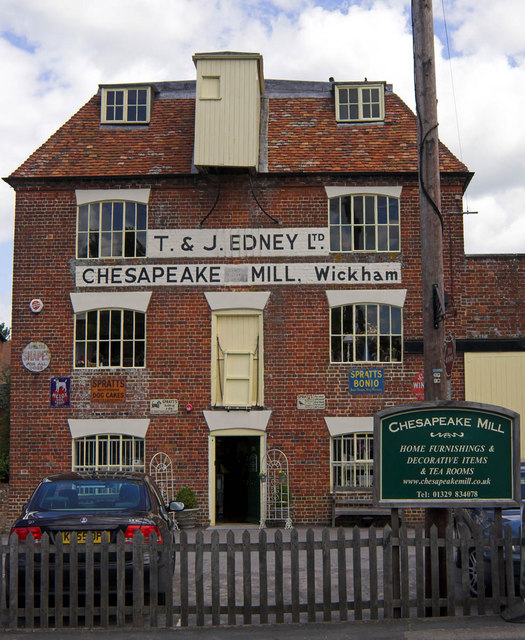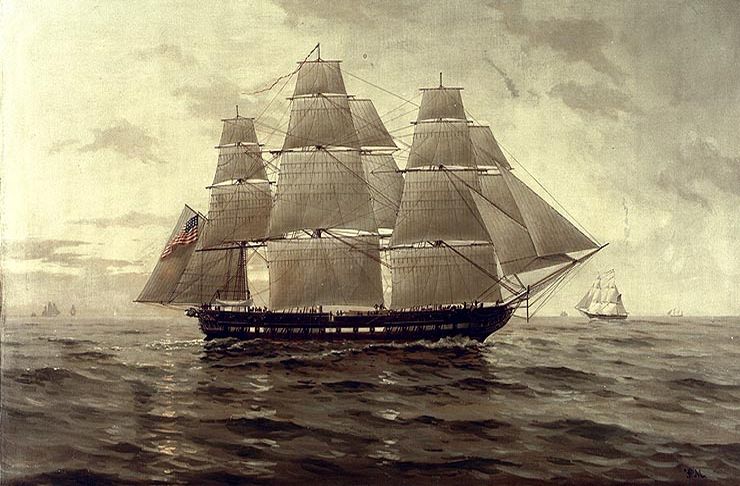Chesapeake Mill: A Case of Industrial Recycling

Very recently the writer had occasion to visit the small but delightful town of Wickham, in Hampshire. The town has a long history which dates back to at least Roman times. An ancient fording point across the river Meon at this location gave access to important Roman centres such as Chichester, Southampton and Winchester. Excavations in recent years have unearthed evidence of a Roman pottery which manufactured roofing tiles, pottery and other ceramic items.
The sixteenth and seventeenth centuries brought new industries to Wickham, including flour milling, ironworking including the manufacture of edged tools, brewing and tanning. Two bridges span the river Meon and at one time each had an adjacent water mill. One of these mills, the subject of this article, still exists and is currently used as an antiques emporium. In more recent times the main industry of the area was Market Gardening, the produce from this enterprise being speedily conveyed to Portsmouth and Gosport via the Meon Valley Railway.
Left – Chesapeake Mill, Richard Thomas & Chesapeake Mill via Wikimedia Commons
Wickham has a market square and a number of fine Georgian buildings, erected on the prosperity of past times. The history of naval ships and seafaring are never very far below the surface in much of Hampshire, and this is most certainly the case with Wickham. The intriguingly named Chesapeake Mill is a finely preserved industrial building with a strong naval connection.
Our story really begins in June 1812 with the declaration of war by the United States Congress on the United Kingdom. This decision stemmed from a number of provocative incidents involving embargo’s on free trade between the United States and Napoleonic France, enforced by the Royal Navy. Britain of course was deeply committed to a war with France and wanted to deny any succour to their enemy from outside sources. Another source of Congress irritation was the “pressing” of American citizens into British naval service on behalf of King George!
After the resounding victory at Trafalgar, it was assumed that the Royal Navy would be omnipotent in all subsequent maritime engagements. However, the war with the United States resulted in several Royal Navy vessels and a number of merchant ships being ignominiously captured by the fledgling American navy. This was a source of acute embarrassment to the admiralty and great annoyance to the British public. The problem had to be addressed.
The USS Chesapeake was designed originally as a 44 gun frigate, but during her construction she was modified to a 38 gun ship. She was longer in length and narrower in the beam than equivalent British frigates, and therefore somewhat faster. Built at the Gosport Virginia navy yard, the Chesapeake was launched on 2nd December 1799.
Early in her career Chesapeake was involved in the Quasi – Wars with France. Subsequently she saw action in the First Barbary War. The Chesapeake, in June1807, was fired upon by the Royal Navy vessel HMS Leopard, for refusing to allow a search for deserters. This incident was instrumental in Congress taking its decision to declare war on Britain in 1812. A major triumph for the Chesapeake was the seizing of five British merchant ships. Along with her companion frigates, USS Constitution and USS America, the Chesapeake was becoming a thorn in the side of the Royal Navy.
The Chesapeake received a new commander in the Spring of 1813. He was 31 year old Captain James Lawrence (1781-1813) who had previously achieved a degree of fame for his capture of the British sloop, HMS Peacock. At this time Chesapeake was undergoing a refit at Boston navy yard. However, the Royal Navy in the form of HMS Shannon, a 38 gun frigate commanded by Captain Sir Philip Bowes Vere Broke (1776 -1841), was on the track of the Chesapeake.
Captain Broke was a very able commander and gunnery expert, who had brought his crew and ship to the peak of efficiency, and he desired to test them against Lawrence’s Chesapeake. In the summer of 1813 Broke arrived off the coast at Boston, gathering intelligence that the Chesapeake was about to set sail. Broke composed a letter to Captain Lawrence with an invitation to join him in battle, indicating he was short of food and water and he could not wait too long for the contest to begin. Although the note was sent to Lawrence he did not receive it, having already sailed from Boston.

The action between the Chesapeake and Shannon took place on 1st June 1813 at Cape Ann, just off Boston. The engagement was short and bloody. In a mere twelve minutes the Chesapeake was disabled, boarded and and taken by the crew of the Shannon. Casualties on both ships were heavy. Captain Lawrence was mortally wounded and Bowes Vere Broke severely injured, although he did survive to make a partial recovery. The total number killed from both vessels exceeded one hundred and the surviving wounded numbered one hundred and twenty seven.
Right – USSChesapeake F. Muller, Public domain, via Wikimedia Commons
During the encounter Captain Lawrence was heard to utter the command, “Don’t give up the ship”. His exhortation to his crew has gone down in US Navy folklore and is still used today as a rallying call on American ships. Similarly, in the Royal Navy, Sir Philip Bowes Vere Broke,KCB is remembered at naval dinners with the toast, “An Irish River and an English Broke”. His victory is viewed as one of the most brilliant naval actions on record.
After the battle makeshift repairs were conducted and both vessels were sailed to Halifax, Nova Scotia, where a triumphal entrance was made into the harbour there. The body of Captain Lawrence was given a full military burial with a guard of honour. Somewhat later his remains were disinterred and removed to the United States to be reburied in Trinity Churchyard, New York. Bowes Vere Broke was conveyed to the Governor’s Residence where he was nursed back to a partial restoration of health. Due to his injuries he never commanded another ship, and retired to his country estate in Suffolk. His reputation stood very high in the Royal Navy and a wider appreciative public.
The Chesapeake was repaired in the naval dockyard at Halifax, before being sailed to England. There was now an opportunity for the admiralty to have a closer look at the vessel and assess her qualities, including methods of construction and lofting lines. After this the Chesapeake was taken on charge by the Royal Navy and used for escort duties.
In 1819 the Chesapeake was removed from active service and sold to a commercial ship breakers at Portsmouth. Many of the Chesapeake’s timbers were still eminently serviceable and these were sold off in an auction sale. The purchaser of the timbers was a Mr John Prior, a flour miller, who intended to incorporate them into a new flour watermill he was building at Wickham. This was duly done; the dimensions of the available timbers largely governing the size of the new mill. The construction of Chesapeake Mill took place in 1820, replacing an earlier building on the same site.
Rather surprisingly much of the timber from the Chesapeake was not oak as one would expect, but Southern Pine, a straight grained softwood. This type of timber was ideal for ships’ deck beams, being fairly light in weight and available in long lengths. These large section members were incorporated in the new mill to support the various floors. Additionally, shorter lengths of smaller section timber were used for door and window lintels. Planking that once covered the ship’s ribs is also to be found in the mill. Other than perhaps naval dockyard situations, it has been said that Chesapeake Mill represents the finest reuse of ship’s timbers, in a building, in this country.
Chesapeake Mill originally had two waterwheels which drove five pairs of millstones. Later a water turbine replaced both waterwheels. The mill operated for over 150 years, not closing down until the 1970s. The mill’s current use as an antiques centre has enhanced and extended the life of the building and brought it to the attention of a much wider public. A very fine example of nineteenth century recycling using redundant materials.
John Willock, 2021
References;
- The History of the Chesapeake Mill, The Chesapeake Mill Ltd.
